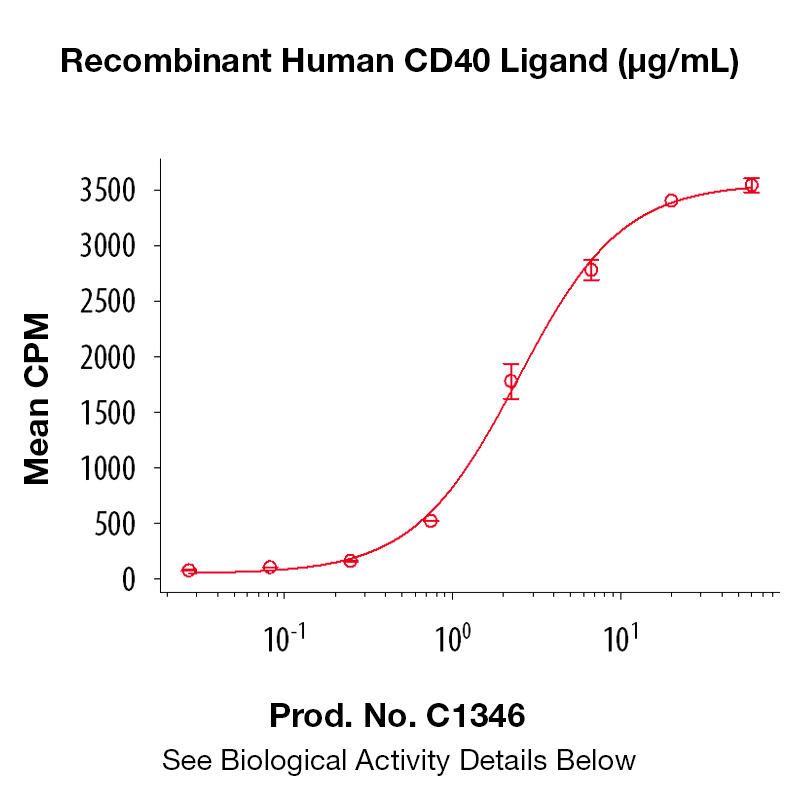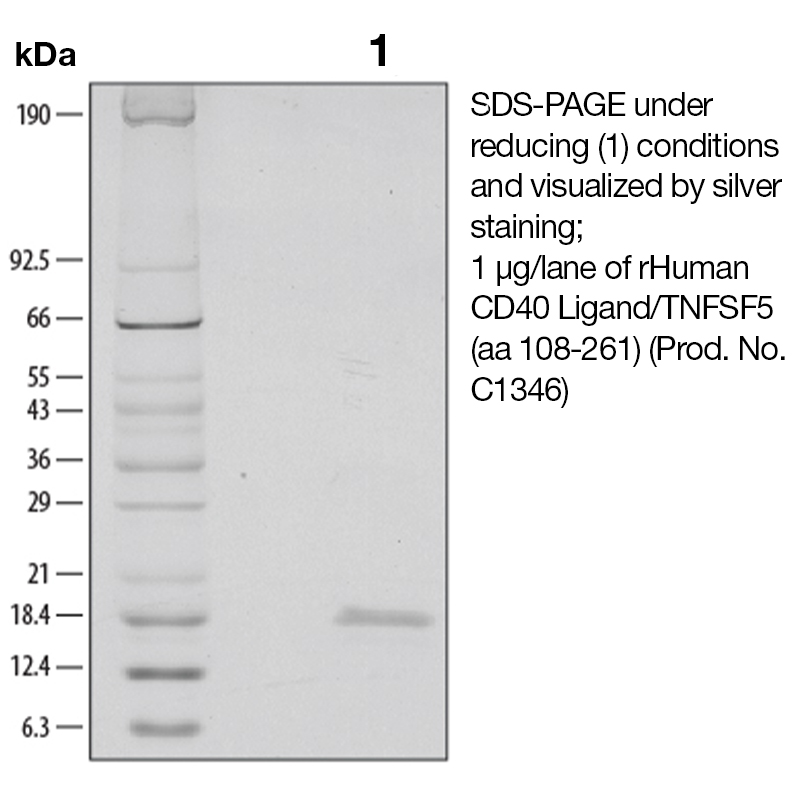Recombinant Human CD40 Ligand (aa 108-261)
Data
- -
- -
BackgroundCD40 is a 48 kD type I transmembrane glycoprotein that is a member of the TNFR superfamily. CD40, in association with its ligand CD154 (CD40L) - a 39 kD protein, acts as a costimulatory molecule for the activation of B cells, dendritic cells, monocytes, and other antigen presenting cells. CD40 is involved in Ig isotype switching and dendritic cell maturation, as well as the activation, differentiation and proliferation of B cells. CD40 interacts with TNFR2 and is involved in the regulation of signal transduction. CD40 is a potential target for cancer immunotherapy. Blocking the interaction of CD40 with its ligand (CD154) is the sought-after therapeutic objective for preventing and/or improving both autoimmune diseases and transplant rejection. Studies have shown that monoclonal antibodies that block CD154 in human clinical trials resulted in unanticipated vascular complications. Hence, an interest in the therapeutic potential for antagonist mAbs specific for human CD40 is emerging. Antibodies of particular therapeutic interest are those that do not inhibit CD40 signaling via physical competition with CD154. Additionally, the interaction of CD40 and its ligand (CD154) is found to be essential for amyloid-beta-induced microglial activation, thus plays a significant part in Alzheimer disease pathogenesis. Protein DetailsPurity >97% by SDS-PAGE and analyzed by silver stain. Endotoxin Level <0.1 EU/µg as determined by the LAL method Biological Activity The biological activity of Human CD40L was determined by its ability to stimulate proliferation of B cell-enriched PBMC in the presence of 20 ng/ml of recombinant human IL-4 (Spriggs, M.K. et al., 1992, J. Exp. Med. 176:1543 - 1550). The expected ED<sub>50</sub> for this effect is typically 1 - 3 μg/ml. Protein Accession No. Amino Acid Sequence mensfemqkg dqnpqiaahv iseassktts vlqwaekgyy tmsnnlvtle ngkqltvkrq glyyiyaqvt fcsnreassq apfiaslclk spgrferill raanthssak pcgqqsihlg gvfelqpgas vfvnvtdpsq vshgtgftsf gllkl N-terminal Sequence Analysis Met State of Matter Lyophilized Predicted Molecular Mass The predicted molecular weight of Recombinant Human CD40L is Mr 16.9 kDa. However, the actual molecular weight as observed by migration on SDS Page is Mr 18 kDa. Predicted Molecular Mass 16.9 Formulation This recombinant protein was 0.2 µm filtered and lyophilized from a sterile solution containing 20 mM phosphate buffer, 200 mM NaCl and 0.1 mM EDTA pH 7.0. Storage and Stability This lyophilized protein is stable for six to twelve months when stored desiccated at -20°C to -70°C. After aseptic reconstitution, this protein may be stored at 2°C to 8°C for one month or at -20°C to -70°C in a manual defrost freezer. Avoid Repeated Freeze Thaw Cycles. See Product Insert for exact lot specific storage instructions. Country of Origin USA Shipping Next Day Ambient NCBI Gene Bank References & Citations1. Baumert, TF. et al. (2005) Blood.105(9):3605-14. Article Link 2. Libby, P. et al. (2004) Am J Pathol.165(5):1571-81. PubMed 3. Libby P. et al. (2003) Circulation. 107(22):2829-36. Article Link 4. Schönbeck, U. et al. (2002) J Biol Chem. 277(28):25032-9. Article Link Certificate of AnalysisIMPORTANT Use lot specific datasheet for all technical information pertaining to this recombinant protein. |
Related Products
- -
- -
Prod No. | Description |
|---|---|
C2828 | |
C2829 | |
C2823 | |
F1195 | |
C1417 | |
C845 | |
C1383 | |
C386 | |
C1346 | |
C1336 | |
C1499 | |
C1166 | |
C1586 |




